Orchard habitat
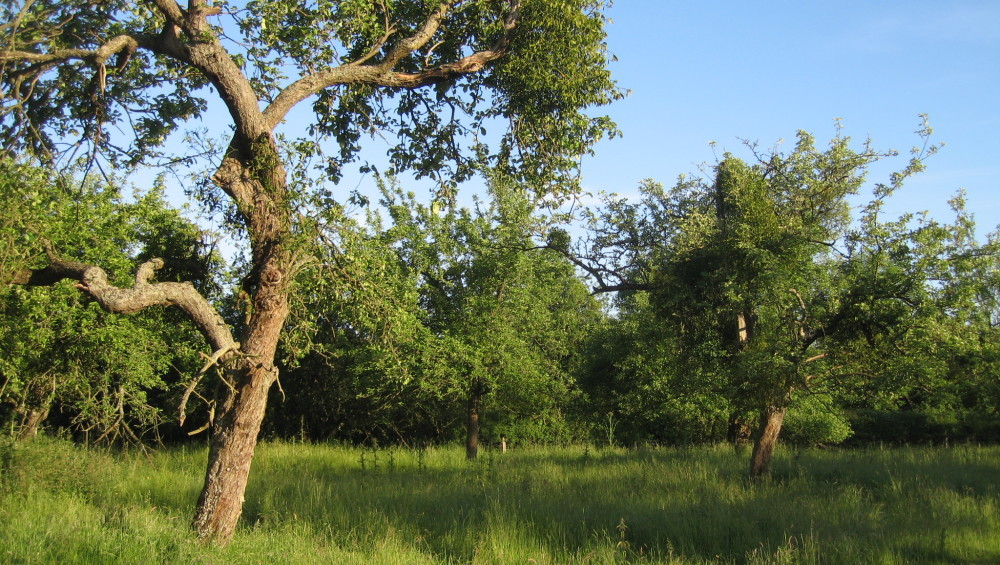
Traditional orchards contain a mosaic of habitats important to wildlife and provide food shelter and breeding sites for many different species.
Why are traditional orchards so great for biodiversity?
Orchards are a mosaic habitat
The habitat contains elements of woodland, pasture, meadow grassland, is often bordered by hedgerows and can also include areas of scrub. As good as each of these habitats are on their own, they combine in your orchard to create a wildlife haven more than the sum of its parts. These vegetation types add to the plant diversity and create a mosaic of habitats to support a vast range of species.
Orchard trees and dead wood
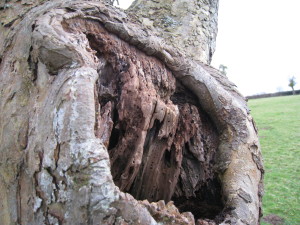 Wood decay is part of the natural ageing process of a tree, and old fruit trees have a particular way of aging with hollow trunks, cracks in bark and rot holes that provide an incredible habitat for all manner of invertebrates, fungi, birds, bats and other small mammals. From a wildlife perspective, standing decaying wood is one of the most valuable elements of the orchard habitat. Cavities in veteran or even dead trees provide some of the most important habitats in the natural world. Indeed, it was such a cavity in an oak tree that once saved the life of a king.
Wood decay is part of the natural ageing process of a tree, and old fruit trees have a particular way of aging with hollow trunks, cracks in bark and rot holes that provide an incredible habitat for all manner of invertebrates, fungi, birds, bats and other small mammals. From a wildlife perspective, standing decaying wood is one of the most valuable elements of the orchard habitat. Cavities in veteran or even dead trees provide some of the most important habitats in the natural world. Indeed, it was such a cavity in an oak tree that once saved the life of a king.
In time, internal deadwood decays to a soil-like substance known as wood mould, or saproxylic humus. This accumulates in the cavities where the protection it affords from the worst of the elements maintains a consistent temperature and humidity that is essential for sheltering mammals, nesting bats and birds, and many rare saproxylic organisms. Enriched by the animal droppings, feathers, bones and other detritus, this develops over the period of decades – which is why trees on standard rootstocks are so important.
If there is risk of water penetration into a cavity, prevent the loss of the dry standing deadwood habitat by capping cavities with old tiles, slabs of wood, or even roofing felt. Collect loose detritus and transfer it into other cavities to provide habitat continuity.
Ageing trees naturally die-back (senesce) and begin to hollow out helping them to remain standing, recycling nutrients and ultimately thriving for longer. Dead and decaying wood, therefore, does not necessarily mean that a tree is in poor health. It will still be able to survive and produce fruit for many years to come whilst providing valuable habitat.
A well-managed established orchard has mixture of tree ages. Young trees allow plenty of light to reach the grassland and older trees provide shelter and food thus further adding to the diversity of habitat available for nature.
Unimproved grassland
The grasslands in many traditional orchards have been undisturbed for decades if not longer and have escaped agricultural improvement. Both the nitrogen and the phosphorous from fertilisers contribute to the loss of plant diversity in grasslands common in traditional orchards. Woodland and meadow wildflowers are often species adapted to nutrient poor soil and are more sensitive to these nutrients. In some cases this sensitivity means the addition of fertiliser is directly toxic to them.
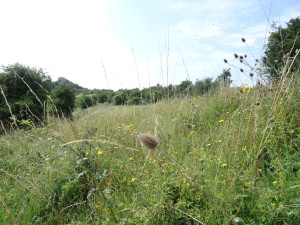 As well as this, plant species found in nutrient poor soils are often shorter in stature than those adapted to nutrient rich conditions and are less able to cope with shading. This means adding nutrients to your orchard soil alters the competition balance and most of the small wildflowers will be outcompeted by nutrient loving plants such as docks and nettles. Don’t let the word ‘poor’ in ‘nutrient poor’ put you off, this soil type is fantastic for plant diversity.
As well as this, plant species found in nutrient poor soils are often shorter in stature than those adapted to nutrient rich conditions and are less able to cope with shading. This means adding nutrients to your orchard soil alters the competition balance and most of the small wildflowers will be outcompeted by nutrient loving plants such as docks and nettles. Don’t let the word ‘poor’ in ‘nutrient poor’ put you off, this soil type is fantastic for plant diversity.
It is not only plant diversity that is directly affected by nutrient enrichment, it reduces the diversity of mycorrhizal fungi in the soil. As nearly 80% of plants require these mycorrhizal fungi to thrive, this can add to the loss of plant diversity.
Orchards occur on a wide range of soil types from acidic infertile soils to fertile river floodplains and lime rich soils. This influences the plant communities that grow, and so also affects the invertebrates you can find.
Minimal soil disturbance
Because it is impossible to plough an orchard without running the risk of damaging the tree roots, the soil in orchards have often been left undisturbed for as long as the orchard has been standing. Unlike most forms of cultivation which lead to a gradual decline in soil structure, the structure of orchard soil is left largely intact, and the complex ecosystem of the subterranean world undisturbed. The result is reduced soil erosion and less damage to fungal hyphae networks. Whilst some plants thrive in disturbed soil there are others that prefer this undisturbed soil structure. Among these are native orchids which require the mycorrhizal soil fungi present in healthy, unimproved and undisturbed soils for germination and growth.
Minimal use of herbicides and pesticides
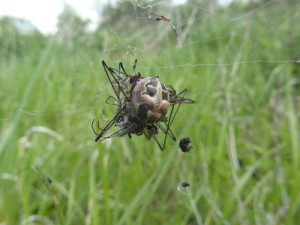 When you use herbicides and pesticides in any ecosystem you end up reducing the overall biodiversity of the site, not just the pest species. Not only this, but clearing this ecological space opens it up for colonisation by more competitive and aggressive species. Weed plants, for example often achieve this status because of their exceptional ability to disperse and colonise. This means that the species composition will be altered from it can take a long time to recover.
When you use herbicides and pesticides in any ecosystem you end up reducing the overall biodiversity of the site, not just the pest species. Not only this, but clearing this ecological space opens it up for colonisation by more competitive and aggressive species. Weed plants, for example often achieve this status because of their exceptional ability to disperse and colonise. This means that the species composition will be altered from it can take a long time to recover.
This is not to say that these treatments don’t have their place in agriculture or even in your orchard, just that the low levels of spraying typical in traditional orchards affords lower levels of impact on the resident biodiversity.
Forage for pollinators
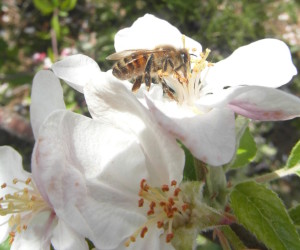 In spring when your orchard is in full blossom your trees provide a feast for local pollinator communities. Not only does this make sure you get a good harvest (blossom needs to be pollinated to set fruit) but it gives pollinators a good supply of nectar and pollen. Depending on how you manage your orchard grassland, this will also provide good forage for pollinator communities through the whole of the summer.
In spring when your orchard is in full blossom your trees provide a feast for local pollinator communities. Not only does this make sure you get a good harvest (blossom needs to be pollinated to set fruit) but it gives pollinators a good supply of nectar and pollen. Depending on how you manage your orchard grassland, this will also provide good forage for pollinator communities through the whole of the summer.
The UK is seeing a worrying decline in wild pollinators. Although there are many compounding factors for this decline, two of the largest are the overwhelming loss of wildflower-rich grasslands in the UK, and the intensification of modern agriculture.
The fruit
No m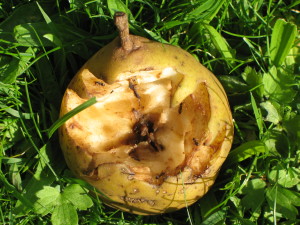 atter how much of the fruit in your orchard you use yourself, there is almost always a good amount left over for biodiversity. Even if this is just the overripe, bruised, holed or slightly rotten fruit that we don’t want to eat ourselves.
atter how much of the fruit in your orchard you use yourself, there is almost always a good amount left over for biodiversity. Even if this is just the overripe, bruised, holed or slightly rotten fruit that we don’t want to eat ourselves.
This fruit source benefits all manner of birds like thrushes and fieldfares, mammals such as hedgehogs, hares and badgers and a huge variety of invertebrates such as butterflies, beetles, and wasps (which for much of the year do us a favour as natural pest controllers).
Habitat connectivity
Orchards increase habitat connectivity in fragmented landscapes. Habitat loss and fragmentation are two of the main threats to much of our wildlife. Orchards, hedgerows and woodlands act as stepping stones or corridors, helping many species to disperse, interact and avoid isolation which can otherwise lead to local extinction. This network of habitats is also important at the landscape scale to sustain scarce species that require continuity of habitat through time.
Each Traditional Orchard is unique
Each orchard is different, with its own set of characteristics and features, and each can provide a refuge for wildlife, both endangered and not.
For more information on how to discover the amazing variety of things that live in your orchard, visit our discover orchard wildlife page, or download Traditional orchards, a guide to wildlife and management
